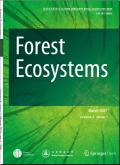Endemic threatened tree species in the Mediterranean forests of central Chile are highly sensitive to ENSO-driven water availability and drought
IF 4.4
1区 农林科学
Q1 FORESTRY
引用次数: 0
Abstract
The Mediterranean region in central Chile is experiencing a significant decrease in precipitation due to climate change and the dynamics of the El Niño Southern Oscillation (ENSO). Droughts have increased in recent decades, with the most severe and longest drought of the last millennium occurring since 2010 in central Chile. The impact of ongoing water scarcity is leading to significant drought-related declines in tree growth and forest dieback in the Mediterranean region. A deep understanding of how tree species respond to climate is crucial to accurately predict how forests will respond to climate change. We examined the growth responses to climate of three endemic and threatened tree species of the Mediterranean forests of central Chile, Nothofagus macrocarpa, Cryptocarya alba and Persea lingue, in a protected area. We observed that the growth of all three species was highly dependent on water availability and ENSO, and that the evergreen species C. alba and P. lingue increased their sensitivity to hydroclimate more than the deciduous species N. macrocarpa. These relationships were consistent across much of southern South America, highlighting the dependence of these species on water availability at large geographic scales. We found that there is a relationship between local water availability and ENSO that has intensified temporally and expanded geographically in recent decades. The xerophyllous species C. alba showed greater resistance and increasing resilience to severe droughts, while P. lingue and N. macrocarpa showed greater growth decline during droughts, possibly due to their preference for wetter environments. Our results highlight the crucial role of ENSO-driven water availability and drought in limiting tree growth and threatening the conservation of Mediterranean forests in central Chile.
智利中部地中海森林中的特有濒危树种对enso驱动的水分供应和干旱高度敏感
由于气候变化和厄尔Niño南方涛动(ENSO)的动力,智利中部的地中海地区正在经历降水的显著减少。近几十年来,干旱有所增加,自2010年以来,智利中部发生了上个千年来最严重、持续时间最长的干旱。持续缺水的影响正在导致地中海区域与干旱有关的树木生长和森林枯死的显著下降。深入了解树种对气候的反应对于准确预测森林对气候变化的反应至关重要。研究了智利中部地中海森林三种特有种和濒危树种Nothofagus macrocarpa、Cryptocarya alba和Persea lingue的生长对气候的响应。结果表明,三种植物的生长均高度依赖于水分有效性和ENSO,且常绿树种C. alba和P. lingue对水文气候的敏感性高于落叶树种N. macrocarpa。这些关系在南美洲南部大部分地区是一致的,突出了这些物种在大地理尺度上对水供应的依赖。我们发现,近几十年来,当地水资源供应与ENSO之间的关系在时间上增强,在地理上扩大。旱生植物C. alba对严重干旱表现出更强的抵抗力和复原力,而P. lingue和N. macrocarpa在干旱期间表现出更大的生长衰退,这可能是由于它们对湿润环境的偏好。我们的研究结果强调了enso驱动的水分供应和干旱在限制树木生长和威胁智利中部地中海森林保护方面的关键作用。
本文章由计算机程序翻译,如有差异,请以英文原文为准。
求助全文
约1分钟内获得全文
求助全文
来源期刊

Forest Ecosystems
Environmental Science-Nature and Landscape Conservation
CiteScore
7.10
自引率
4.90%
发文量
1115
审稿时长
22 days
期刊介绍:
Forest Ecosystems is an open access, peer-reviewed journal publishing scientific communications from any discipline that can provide interesting contributions about the structure and dynamics of "natural" and "domesticated" forest ecosystems, and their services to people. The journal welcomes innovative science as well as application oriented work that will enhance understanding of woody plant communities. Very specific studies are welcome if they are part of a thematic series that provides some holistic perspective that is of general interest.
 求助内容:
求助内容: 应助结果提醒方式:
应助结果提醒方式:


